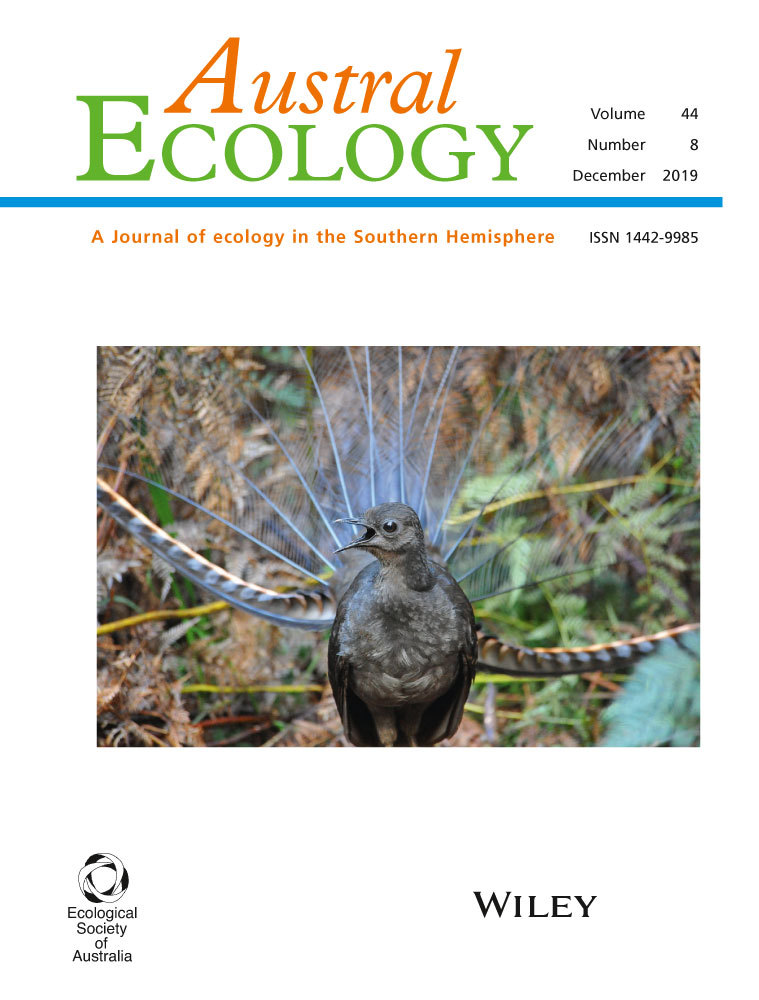Competitive effects and responses of the invasive grass Eragrostis plana in Río de la Plata grasslands
Abstract
enThe ability of an invasive species to establish is mostly determined by its biotic interactions with native species from the recipient community. Here, we evaluate the competitive effects and responses of the invasive Eragrostis plana when interacting with native species, in order to identify possible mechanisms driving invasion in Río de la Plata grasslands. A pairwise competition experiment was performed consisting of treatments that varied in the identity of neighbour plant species: (i) control (no interaction); (ii) intraspecific interaction; (iii) interspecific interaction between native and invasive species; and (iv) interspecific interaction between two co-occurring native species. Data analysis was separated into the effect of E. plana on the performance of three native perennial grasses (target species: Aristida laevis, Eragrostis neesii and Paspalum notatum) and the response of E. plana to natives (target species: E. plana). Separately for each target species, components of plant performance were compared between neighbouring species treatments. We found that the strength of competitive interactions depended on both target and neighbour species identity. Regarding natives, interspecific competition was stronger than intraspecific. Native species showed distinctive responses to whether the neighbour was the invasive or a co-occurring native (Eragrostis lugens). Competition between E. plana and native species was stronger than between co-occurring natives. We demonstrated E. plana had a greater negative effect on native's species performance than the native congener E. lugens. Regarding E. plana, intraspecific competition was stronger than interspecific, and its response was positive or neutral when interacting with natives, suggesting its high tolerance to grow in competition with neighbours. We conclude E. plana's negative effects on native species performance, and its positive or neutral responses to neighbouring native plants demonstrate its strong competitive ability in the recipient community. This may explain its invasion success in southern Brazil and in the encompassing Río de la Plata grasslands.
Resumen
esLa capacidad de establecimiento de una especie invasora está fuertemente asociada al resultado de las interacciones bióticas con las especies de la comunidad residente. En este trabajo, se evaluaron los efectos y respuestas competitivas de la gramínea invasora Eragrostis plana, para identificar posibles mecanismos de invasión en los pastizales del Río de la Plata. Para ello, se realizó un experimento de competencia, par a par, donde se manipuló la identidad de las especies de plantas vecinas: (i) control (sin interacción); (ii) interacción intraespecífica; (iii) interacción interespecífica entre especies nativas e invasoras; e (iv) interacción interespecífica entre dos especies nativas coexistentes. El análisis de datos fue separado en el efecto de E. plana sobre el desempeño de tres gramíneas perennes nativas (especies blanco: Aristida laevis, Eragrostis neesii y Paspalum notatum); y en la respuesta de E. plana a dicha interacción (especie blanco: E. plana). Para cada especie por separado, se comparó el desempeño entre los distintos tratamientos de competencia intra e interespecífica (i-v). Como resultado, se observó que los efectos y las respuestas competitivas dependen tanto de la identidad de la especie blanco como de la especie vecina. En lo que refiere a las especies nativas, la competencia interespecífica fue más intensa que la intraespecífica. Además, las tres gramíneas nativas mostraron respuestas diferentes asociadas a si el competidor es una especie nativa de la comunidad (Eragrostis lugens) o una invasora (E. plana), revelando una mayor intensidad competitiva con esta última. Sin embargo, con respecto a E. plana, se observó una mayor intensidad en la competencia intraespecífica. Su respuesta fue positiva o neutra al interactuar con las tres gramíneas nativas, lo cual sugiere su gran tolerancia al competir con especies de la comunidad residente. En suma, los efectos negativos de E. plana sobre el desempeño de especies nativas y sus respuestas positivas o neutras en esta interacción, demuestran su gran capacidad competitiva con la comunidad residente. Esto podría explicar su éxito de invasión en el sur de Brasil y en los pastizales del Río de la Plata.
Introduction
Non-native plants have to overcome many barriers to naturalise and become invasive in the introduced range (Richardson et al. 2000). Invasion success depends mainly on three factors: the species inherent invasiveness, propagule pressure and the susceptibility of the ecosystem to become invaded (Londsale 1999; Richardson et al. 2000; Davis 2005). Regarding community invasibility, it is principally determined by the outcome of biotic interactions between invasive and resident species, where the recipient community often imposes a competitive resistance to reduce invasion success (Callaway & Aschehoug 2000; Bakker & Wilson 2001; Daehler 2003; Hager 2004; Levine et al. 2004; Vilà & Weiner 2004; Davis 2005; Mitchell et al. 2006; Hierro et al. 2011). The result of these interactions may depend on the ability of the invasive species to compete for limiting resources within the recipient community, which can be separated into two components: the effect on and the response to, neighbouring plants (Goldberg & Werner 1983; Miller & Werner 1987; Goldberg 1990).
The competitive effect refers to the ability of a species to suppress the growth of neighbouring plants mainly through depletion of resources, while the competitive response refers to the ability of a species to tolerate resource levels that have been reduced due to competition (Goldberg & Werner 1983; Miller & Werner 1987; Goldberg 1990). It is expected that a successful invasive species has higher competitive ability than natives, as a possible mechanism to guarantee its establishment (Bakker & Wilson 2001; Vilà & Weiner 2004; Young & Mangold 2008; Gruntman et al. 2014; Schultheis & MacGuigan 2018). Thus, invasive species should be able to reduce the performance of residents (i.e. high competitive effects) and to tolerate growing in competition with neighbouring plants (i.e. low competitive response). Moreover, invasive species may have strategically weaker competitive effects on conspecifics than heterospecifics, which may result in self-facilitation for spreading (Conway et al. 2002; Bossdorf et al. 2004).
However, results about the effects and responses of invasive species are still little discussed in the literature (Hager 2004; Suding et al. 2004; Thomsen et al. 2006; Gruntman et al. 2014; Moyer & Brewer 2018; Schultheis & MacGuigan 2018), and there are even less studies which considered the relative strength of intra- and interspecific competition between neighbouring plants of recipient communities (Hager 2004; Mangla et al. 2011). For addressing the hypothesis that invasive species are better competitors than natives, the effect of the invader on target natives should be compared to the relative effect of natives on other co-occurring native species (Vilà & Weiner 2004), which provides an adequate control for neighbour's identity (i.e. invasive vs. native relative effect). If an invasive species is competitively superior to co-occurring natives, we would expect a greater suppression of target species (greater effect of the invader) and more ability to tolerate competition with neighbouring plants (weaker response of the invader). However, this approach has been neglected in the literature, but can be an important step for understanding interactions in recipient community which may determine the strength of invasion resistance.
We focus on the invasive species Eragrostis plana Ness (Poaceae; commonly named ‘Capim Annoni’ or ‘South African lovegrass’), a perennial grass from South Africa that was introduced and cultivated in the state of Rio Grande do Sul, Brazil. Over the last decade, it has become the most invasive plant in the natural grasslands of southern Brazil (Medeiros & Focht 2007; Guido & Guadagnin 2015; Guido et al. 2016). These grasslands extend to the south and west of South America, encompassing the Rio de la Plata grasslands, which also includes Uruguay and the north-eastern of Argentina (Soriano 1992). E. plana has spread fast, becoming invasive also in Uruguay (Masciadri et al. 2010; Fonseca et al. 2013) and potentially in other regions of South America (Barbosa et al. 2013). Its invasion not only impacts grassland biodiversity, reducing resident species cover and richness (Guido & Pillar 2017; Dresseno et al. 2018), but also reduces livestock production due to its relatively low palatability (Medeiros & Focht 2007). Although the invasion of E. plana is currently an important ecological and economical threat to Río de la Plata grasslands, the factors that facilitate its invasion and the mechanisms by which E. plana displaces native species remain unclear.
Here, we explore the competitive effects and responses of E. plana, due to identify its biotic interactions with native species in the recipient community. We performed a pairwise interaction experiment to evaluate the intra- and interspecific interactions between E. plana and three native perennial grasses (Aristida laevis (Nees) Kunth, Eragrostis neesii Trin. and Paspalum notatum Flüggé), which are abundant in southern Brazil grasslands. We investigated the following questions: (i) What is the effect of E. plana on the performance of the three target native species? (ii) What is the response of E. plana to intra- and interspecific interactions? (iii) Is competition between species from the resident community and E. plana more intense than competition between co-occurring native species? We hypothesised that invasive and native grasses differ in their competitive ability and that these differences would become evident in their performance when interacting with each other. As a mechanism explaining invasion success, we expected that in the recipient community, (i) E. plana had a greater suppression on the performance of natives than a co-occurring native species did (i.e. stronger competitive effect of the invader); (ii) E. plana would have high tolerance to competition with neighbours (weaker competitive response of the invader); and (iii) interspecific interactions would have a greater negative effect on E. plana compared to intraspecific interactions.
Methods
Experimental design
In a greenhouse in Porto Alegre, we performed a pairwise interaction experiment which consisted of four treatments that varied in the identity of the neighbour plant species: (i) control (no interaction); (ii) intraspecific interaction; (iii) interspecific interaction between native and invasive species; and (iv) interspecific interaction between two co-occurring native species. Treatment i consisted of one individual per pot, while ii to iv, two individuals. Treatments i to iii involved the invasive species Eragrostis plana and three native grasses: Aristida laevis, Eragrostis neesii and Paspalum notatum. Treatment iv assessed the interaction of these three natives with the co-occurring native grass Eragrostis lugens (Nees), which was selected because of its taxonomic relatedness and morphological similarity to E. plana. The studied native species are all perennial C4 grasses and are common in grassland communities of southern Brazil. For each species or species pair, seven replicates per treatment were assigned in a complete randomised design. As a result, the experiment involved a total of 98 pots (28, 28, 21 and 21 pots for treatments i, ii, iii and iv, respectively), which were randomly arranged in the greenhouse every week.
All plants were grown from seeds in pots with a diameter of 15 cm, which avoided initial differences in growth and abiotic conditions that may bias final results. During the period March–May of 2016, we collected seeds of each species in a partially invaded natural grassland typical of this region, located in a 5 ha paddock of the Agronomic Experimental Station of Universidade Federal do Rio Grande do Sul (30°07′10″S, 51°41′06″W; 63 m a.s.l). All of the selected species co-occur in this grassland site. Before starting the experiment, we tested the germination of the collected seeds. All species had more than 60% of germination success, except P. notatum, which had <5%. For this reason, we used P. notatum seeds obtained from commercial providers.
We sowed seven seeds of each species per pot to guarantee their establishment. After 1 month, when the seedlings were well established, we selected the biggest and healthiest individual of each species and carefully removed the rest by hand. Consequently, depending on the treatment, one (treatment i) or two individual plants (treatments ii–iv) remained in each pot. Light, water and nutrient availability were homogeneous among all pots during the experiment. Periodically, we measured variables related to plant performance: maximum height (cm), number of leaves and number of tillers. After 12 months, we harvested all of the individuals and separated them into their above- and below-ground parts, before drying (60°C for 48-72 h) and weighing them to obtain their total dry biomass (g). Thus, plant responses to competition were measured by the following variables: maximum height, number of tillers, number of leaves and the total dry biomass (separated into above- and below-ground biomass).
Data analyses
Data analysis was separated into the effect of E. plana on the performance of the three native perennial grasses (target species: A. laevis, E. neesii and P. notatum) and the response of E. plana to them (target species: E. plana). We compared how each target plant performance differed according to the identity of the neighbouring species, that is intraspecific competition or interspecific competition, considering for the latter, the co-occurring native E. lugens or the invasive E. plana.
For evaluating the effect of E. plana on the performance of A. laevis, E. neesii and P. notatum, we used ANOVAs to compare plant performance between the four neighbour treatments (i–iv), separately for each target native species. We considered that E. plana had a real negative effect on these natives not only when neighbouring treatments had lower performance than control (i.e. no interaction), but also when we found a significant difference between both interspecific interaction treatments, indicating that the invasive species had a greater negative effect than the co-occurring native E. lugens (see Vilà & Weiner 2004).
To evaluate the response of E. plana, we compared its performance components between neighbour treatments (i–iii) using ANOVAs. Note that for treatment (iii), there are three possible combinations, as a result of the interactions between the invasive species and each of the three natives (i.e. E. plana + A. laevis; E. plana + E. neesii; E. plana + P. notatum), which resulted in five neighbour treatments in total (i.e. control, intraspecific competition and three different interspecific competition).

Results
The performances of the three native target grasses, A. laevis, E. neesii and P. notatum, were lower when potted with a neighbour plant than when they were growing alone, indicating competitive interactions between neighbouring plants (Figs. 1-3). This is demonstrated in Fig. 3, where the confidence intervals for RII values were always lower than zero for intra- or interspecific competition (Armas et al. 2004). Further, the intensity of competition differed between neighbour identity treatments, and in general, native species performances were higher when competing intraspecifically than interspecifically (Figs. 1-3).
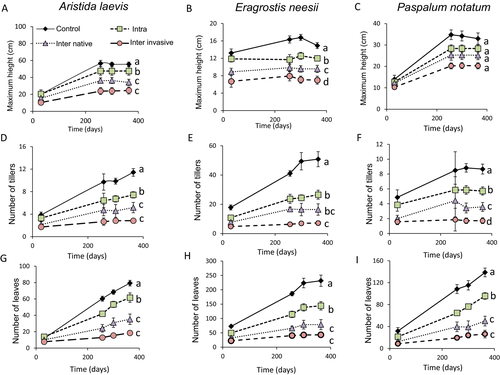
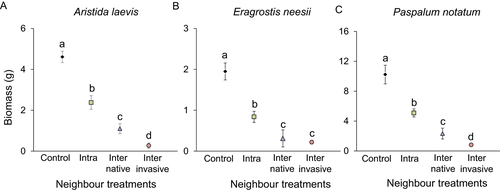
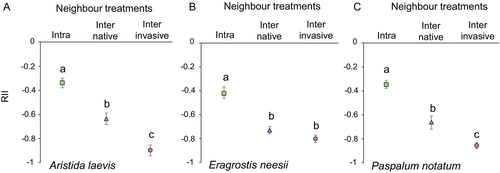
Our results showed that E. plana had negative effects on the performance of A. laevis, E. neesii and P. notatum, but the magnitude of the effects and the significance differed among these three target grasses (Figs. 1-3). After 1 year of the experiment, E. plana reduced the total biomass of A. laevis, diminished the maximum height of E. neesii and decreased the number of tillers and total biomass of P. notatum (Figs. 1 and 2). According to the RII values (Fig. 3), for A. laevis and P. notatum, competition with the invasive E. plana was more intense than when competing with the co-occurring native grass E. lugens. For E. neesii, the RII did not significantly differ between native and invasive neighbour (Fig. 3). Proportional biomass allocation into above- or below-ground (results not shown) was not affected by neighbour identity, as we did not observe significant differences wheather the neighbour was a native (E. lugens) or invasive (E. plana) neighbour, for A. laevis (P = 0.165), E. neesii (P = 0.380) and P. notatum (P = 0.664).
Regarding the invasive species response, we found that the number of tillers, number of leaves and the total biomass of E. plana differed between neighbour identity treatments (P = 0.0001, P = 0.006, P = 0.005, respectively, for each response variable; Figs. 4 and 5). Contrasting with the results of native species, the performance of E. plana was higher, or at least not lower, when potted with a native neighbour than when it was alone (Figs. 4 and 5). Regarding RII values, the response of E. plana was positive when interacting with A. laevis or E. neesii, while its response was close to zero with P. notatum (Fig. 6). Moreover, the RII was negative when interacting with itself (i.e. intraspecific competition; Fig. 6). Biomass allocation of E. plana was not affected by neighbour identity, as we did not observe significant differences (P = 0.182) between the proportion of above- and below-ground biomass among treatments (results not shown).
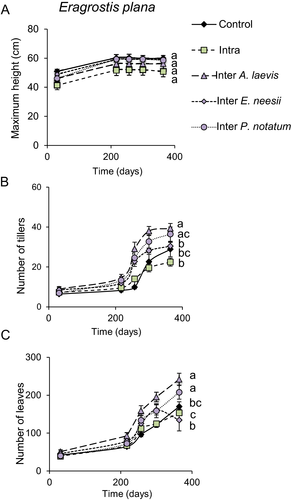

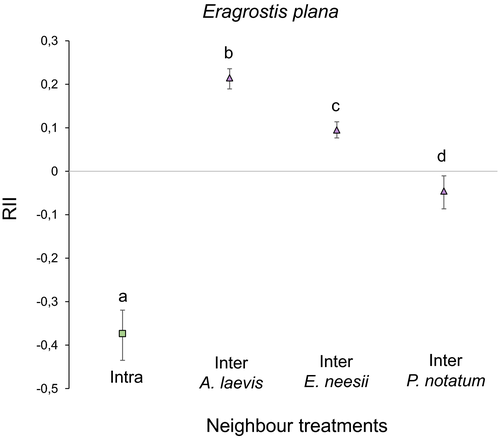
Discussion
Our biotic interactions experiment contemplated three aspects that have been often neglected in the literature: (i) the evaluation of both the effects and responses of an invasive species; (ii) the inclusion of a co-occurring native species competitor, as a species identity control to disentangle the relative effect of the invader in the recipient community; and (iii) the consideration of the relative strength of intra- and interspecific competition between plants. Overall, our expectations were partially confirmed. We showed outcomes not only about the competitive effects and response of an invasive species, but also regarding intra- and interspecific competition between co-occurring native plants. In particular, we demonstrated that E. plana, the most invasive grass of south Brazilian grasslands, reduced the performance of three target native species more than a congener co-occurring native grass (E. lugens) did. Thus, we demonstrated that competition between invasive and native species may be more intense than competition between co-occurring natives. We found E. plana responded either positively or neutrally when interacting with native grasses, and only responded negatively to intraspecific competition, showing its high tolerance to grow with other species in the recipient community. Furthermore, our results were consistent in indicating that the outcomes of interspecific and intraspecific competition depend on target plant identity, as we found stronger interspecific competition for natives, but greater intraspecific competition for the invasive species.
The establishment of an invasive species can threaten the coexistence with natives, mainly because of the negative effects related to competition (Ridenour & Callaway 2001; Levine et al. 2004; Young & Mangold 2008; Moyer & Brewer 2018; Schultheis & MacGuigan 2018). In our plant interaction experiment, in which species neighbour identity was manipulated, we demonstrated the negative effects of E. plana on the performance of co-occurring native grasses. Yet, these effects varied between target species and also depended on which variable of performance was analysed. Overall, E. plana reduced the total biomass of A. laevis and P. notatum, and the number of tillers of the latter, but only reduced the maximum height of E. neesii. These strong competitive effects could be significant at the beginning of the invasion process and may allow the invader to outcompete species from the recipient community, increasing its chance of establishment. Although our experimental design quantified individual effects, our results may allow inferences about the effects in natural plant populations and communities. As the total effect of an invasive plant is multiplied by its total abundance in the area, E. plana-dominated grasslands may be subject to a significant reduction of native plant abundances and species richness, which has already been observed locally in natural grasslands from the study region (Guido & Pillar 2017; Dresseno et al. 2018).
Other studies that have focused on invasive species control suggested that competition with resident species can reduce invasive plant establishment and growth as a biotic resistance mechanism (Lindquist et al. 1996; Hierro et al. 2011). In a simple short-term germination experiment, Guido et al. (2017) demonstrated that some native seeds delayed E. plana germination and decreased its early growth, which could result in a competition avoidance strategy. However, our results only indicated a positive or neutral response of E. plana when growing with native neighbours in later stages (i.e. adult plants). As plants pass through different physiological phases, neighbour effect may depend on the life cycle stage of the target plant (Connell 1983; Farrer & Goldberg 2011). Thus, the competitive response of E. plana may be more important at later stages of the invasion process, where persistence and spread are taking place. E. plana's positive and neutral responses to native neighbours are important for its success, which show its high ability to uptake resources, resulting in higher growth when interacting with A. laevis and E. neesii, or its indifference by tolerating lower resource levels when interacting with P. notatum. Although our experiment did not study mechanisms underlying competition abilities, it is known that E. plana germination can be considerably faster than co-occurring native grasses, as 73.3% of seeds can germinate within 24 h (Guido et al. 2017). This capability of fast germination and initial growth may allow to uptake resources earlier than native species can, providing a competitive advantage in later stages of growth (Goldberg et al. 2001; Hierro et al. 2009; Gioria & Pyšek 2017; Gioria et al. 2018).
Regarding the target native species, our results suggest that interspecific competition has stronger negative effects than intraspecific competition. These results were not expected, as classical competition theory predicts that intraspecific competition should be greater than interspecific, because individuals of the same species share similar resource requirements (Tilman 1982; Aarssen 1983). However, evidence about the relative strength of intra- and interspecific plant competition in experimental studies is context-dependent and tends to show differing results, suggesting that it is not a simple pattern to generalise. Our results are consistent with several other studies, which found that interspecific competition could be predominant for species in their native range (Lowe et al. 2003; Vasquez et al. 2008; Young & Mangold 2008; Mangla et al. 2011), where they have coexisted and shared evolutionary interactions. These results are also consistent with the Vilà and Weiner (2004) meta-analysis, where they showed interspecific competition between native and invasive plants was stronger than intraspecific competition between native species. Yet, E. plana showed stronger intraspecific than interspecific competition, which could result in self-inhibition over longer time and space scales. This result was not expected and differs from other studies that suggested invasive species might have self-facilitation for easily spreading (Conway et al. 2002). However, greater intraspecific competition for invasive species is also documented in the literature (Vilà & Weiner 2004; Vasquez et al. 2008; Young & Mangold 2008; Blank 2010; Mangla et al. 2011), as traits that enhance invasiveness may also enhance intraspecific competition in already invaded communities.
We conclude that the identity of the neighbouring plant species is important for determining the outcome of competitive effects and responses. The three target native species responded differently not only to intra- and interspecific interactions, but also showing distinct responses based on whether the species was a co-occurring native or an invasive neighbour. Our plant interaction experiment demonstrated that invasive species had a greater effect on the performance of native species than a co-occurring native grass did. The combination of E. plana's negative effects, and its positive or neutral responses when interacting with neighbours from the recipient community demonstrate its high competitive ability (i.e. great effect and weak response), which could explain its invasion success in southern Brazil and the encompassing Río de la Plata grasslands. Finally, we demonstrated the expectation that E. plana is indeed a strong competitor, and the invasion resistance imposed by the single native species A. laevis, E. neesii and P. notatum is weak for preventing its establishment. Further, decomposing the competitive ability into effect and response is an important step for studying the mechanisms of community invasibility and species invasiveness underlying invasion processes. In this way, we can understand better how species from the recipient community might be able to impose competitive resistance to E. plana invasion and also the competitive effects of E. plana making its establishment so successful in the studied grasslands.
Acknowledgements
We thank Vasiliki Balogianni, Felícia Fischer, Ricardo Dreyer de Alencastro and Isis Petrocelli da Rosa, who helped during data collection. We thank Claudia Rodríguez for her valuable suggestions on previous version of the manuscript. We are grateful to editor and referees who carefully read our manuscript and gave constructive comments that substantially improved it. This study was supported by CNPq (grants #307689/2014-0 and 402943/2015-5 to VP) and CAPES, Brazil (postdoctoral fellowship #1666246 to AG).
Author's contribution
AG provided the idea and DH and VP helped to design the experiment. AG and DH collected the data; AG analysed it and led the writing of the manuscript. All authors contributed critically to the drafts and gave the final approval for submission.



